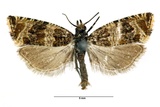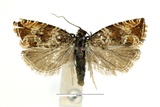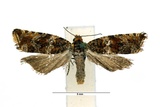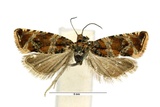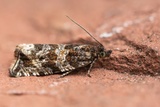Celypha cespitana (Hübner, [1817]) Species
Last modified: Nov. 22, 2025, 5:47 p.m.
A very rare species in Belgium.
Details
- Classification
- Family: Tortricidae > Subfamily: Olethreutinae > Tribus: Olethreutini > Genus: Celypha > Species: Celypha cespitana
- Vernacular names
- Oranjegele lijnbladroller (NL), Thyme Marble (EN), Heide-Thymianwickler (DE)
- First mention in Belgium
- De Sélys-Longchamps E. 1844. Énumération des insectes Lépidoptères de la Belgique. — Mémoires de la Société royale des Sciences de Liége 2: 1–35. On page 21.
- Status
-
Native
Distribution
Imago
Wingspan 12–16 mm. A small species. Very similar to Celypha rivulana and often requires genital dissection for confident identification.
Both species are characterised by the distal edge of the central band, which from the costa is curved to the rear then incised, the second projection is narrow and long and the band then narrows towards the dorsum.
Bionomics
The larva feeds in shoots near roots, and spun or rolled leaves.
Hibernate as a young larva, pupates in the feeding place.
The moth is active during the day, especially when the weather is dry and sunny and later come to light.
Flight periods
The adults fly normally in one generation a year onwards from May till early August. Rarely a second generation appears during mid-August till mid-September. Most observations during June/July.
Observed on
- Host plant (species):
- Armeria maritima
- Host plant (genera):
- Thymus, Trifolium and Limonium
The polyphagous larva is feeding on Cytisus, Trifolium, Calluna vulgaris, Limonium, Armeria, Daphne and Dryas.
Habitat
It inhabits coastal habitats, limestone areas, open and sandy places, grassland and heathland.
